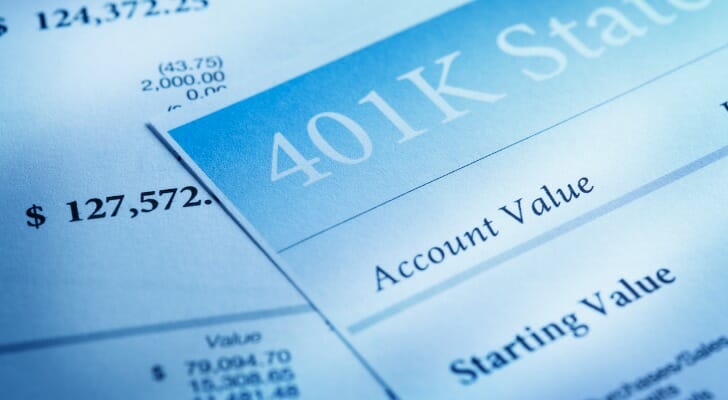 A 401(k) can be a fundamental part of your retirement savings plan. Knowing when – and how – to rebalance 401(k) assets is important for managing risk and achieving your investment goals. Rebalancing simply means selling securities periodically to stay aligned with your preferred asset allocation. This is something that may be done for you if you’re managing your 401(k) through a robo-advisor. But if not, you’ll need to tackle it yourself. The good news is rebalancing a 401(k) isn’t difficult to do. Work with a financial advisor as you rebalance all your retirement investing and savings accounts.
A 401(k) can be a fundamental part of your retirement savings plan. Knowing when – and how – to rebalance 401(k) assets is important for managing risk and achieving your investment goals. Rebalancing simply means selling securities periodically to stay aligned with your preferred asset allocation. This is something that may be done for you if you’re managing your 401(k) through a robo-advisor. But if not, you’ll need to tackle it yourself. The good news is rebalancing a 401(k) isn’t difficult to do. Work with a financial advisor as you rebalance all your retirement investing and savings accounts.
Before You Rebalance Your 401(k)
Before you get started with rebalancing, it’s helpful to review your risk tolerance, time horizon and investment goals. As a general rule of thumb, you can afford to take more risk when you’re younger. As you move into your 50s and 60s, it’s typical to begin reducing your exposure to stocks as you have less time before retirement to recover from any significant market volatility.
Consider what your target asset allocation should be now, based on your age and risk tolerance, and whether it’s changed since the last time you rebalanced. If you’re using an age-based asset allocation rule, for example, you may want to run the numbers again using your current age. So if you’re using the rule of 120 and you’re 35 years old, then you should have 85% of your assets in stocks and 15% in bonds.
You may have completed a risk tolerance or risk assessment questionnaire when you enrolled in your 401(k). While these can be helpful, they’re not necessarily the final word on how you should allocate assets. If it’s been a while since you enrolled, it’s important to reassess your risk tolerance to make sure you’re on the right track with rebalancing.
How to Rebalance Your 401(k)
If you’re ready to rebalance your 401(k) and you know what your target asset allocation should be, the next step is deciding how you want to do it. There are two ways you can rebalance 401(k) assets:
- Sell some of your current investments to bring your asset allocation back in line
- Redirect future contributions toward other investments
In the first scenario, you’d look at where you’re overweighted in your 401(k) then sell off assets. So if you’re overweighted in equities, you could sell off shares of one or more equity funds. If you’re too heavy on bonds, you could sell off a bond fund or two.
The other option is to leave your current asset allocation as-is but change how you invest going forward. So if you’re aiming for an 80% allocation to stocks but you’re currently at 75% you could temporarily adjust your future contributions to go toward stocks. Once you reach the 80% mark, you’d have to readjust your contributions.
Also, consider what type of funds you’re investing in and how those fit your needs. Index funds, for example, follow a passive investing strategy. This means they aim to meet the market, rather than beat it. While index funds can offer consistent returns and relatively low expense ratios, they may not produce the level of returns you’re looking for. So you may prefer a growth fund instead. These funds are designed to beat the market, though there are no guarantees that they will.
There’s no right or wrong way to rebalance, as long as your approach allows you to meet your goals. If you’re not sure which option to pursue, you may want to talk to your benefits coordinator or plan representative. They can walk you through the various options for rebalancing and what types of funds are available.
Is It Smart to Rebalance 401(k)?
 Rebalancing a 401(k) can be a good idea for several reasons, starting with risk management. When building a portfolio for retirement, it’s important to consider your risk tolerance and your risk capacity. Risk tolerance is the amount of risk you’re comfortable taking with your 401(k) investments. Risk capacity represents the level of risk you need to take to achieve your investment goals. If you don’t rebalance 401(k) assets, it’s possible that your risk tolerance and risk capacity may not match up. This could result in taking on too much or too little risk.
Rebalancing a 401(k) can be a good idea for several reasons, starting with risk management. When building a portfolio for retirement, it’s important to consider your risk tolerance and your risk capacity. Risk tolerance is the amount of risk you’re comfortable taking with your 401(k) investments. Risk capacity represents the level of risk you need to take to achieve your investment goals. If you don’t rebalance 401(k) assets, it’s possible that your risk tolerance and risk capacity may not match up. This could result in taking on too much or too little risk.
Say, for example, that you’re 30 years old and your preferred asset allocation is 90% stocks, 10% bonds. The stock portion of your 401(k) outperforms expectations, pushing your asset allocation to 95% stocks, 5% bonds. You could maintain that asset allocation and accept the increased risk posed by having nearly your entire 401(k) in equities. Or you could rebalance to bring it back to the 90/10 split you’re aiming for.
Rebalancing a 401(k) is also important if you’re primarily using target date funds to invest. These funds adjust their asset allocation automatically over time as they get closer to your target date retirement date. But what if you decide to retire five or 10 years early? You might need to be more aggressive with your investing strategy to grow your portfolio. Rebalancing your 401(k) could help you to do that.
Aside from those considerations, 401(k) rebalancing can also offer an opportunity to weed out mutual funds or exchange-traded funds with high expense ratios if the cost isn’t justified by their performance. This can save you money in the long run, allowing you to keep more of your investment returns.
How Often to Rebalance a 401(k)?
There are no hard and fast rules about how often you should rebalance your 401(k). At a minimum, it’s a good idea to rebalance at least once a year. For example, you might choose to do some rebalancing during the fourth quarter. You can also use this time to check your elective salary deferral amounts and consider increasing your 401(k) contributions heading into the new year.
You may consider rebalancing quarterly or semiannually if you’d prefer to check in with your retirement account more often. Or you could use a percentage-based approach to 401(k) rebalancing. For instance, you may choose to rebalance if your asset allocation changes by 5% or 10%. This may require you to check in with your plan more frequently, however, so you may prefer to try quarterly or every six months instead.
The Bottom Line
 Rebalancing your retirement accounts and taxable brokerage accounts if you have them can make it easier to realize your investment goals. If you haven’t rebalanced your 401(k) lately, it may be a good time to consider taking a look at your investment portfolio to make sure they’re still a good fit for your retirement plan.
Rebalancing your retirement accounts and taxable brokerage accounts if you have them can make it easier to realize your investment goals. If you haven’t rebalanced your 401(k) lately, it may be a good time to consider taking a look at your investment portfolio to make sure they’re still a good fit for your retirement plan.
Retirement Planning Tips
- Consider talking to a financial advisor about how to rebalance your 401(k). Finding a qualified financial advisor doesn’t have to be hard. SmartAsset’s free tool matches you with up to three financial advisors in your area, and you can interview your advisor matches at no cost to decide which one is right for you. If you’re ready to find an advisor who can help you achieve your financial goals, get started now.
- Opening an individual retirement account (IRA) can help you supplement 401(k) savings or replace them if you don’t have a retirement plan at work. When opening an IRA, consider whether traditional or Roth works best. Traditional IRAs offer a deduction for contributions while Roth IRAs allow for tax-free distributions in retirement.
- If you’re investing in a taxable brokerage account, it’s also important to rebalance those investments. You can also harvest capital losses to offset capital gains. When done correctly, tax-loss harvesting could help you to reduce what you pay in capital gains tax each year.
Photo credit: ©iStock.com/DNY59, ©iStock.com/xxx, ©iStock.com/benedek